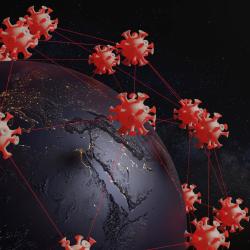What Makes a Bird a Bird?
Sparrows, ravens, canaries and songbirds are seen everywhere. Some are considered annoying pests, while others are beloved pets. Despite the differences in how they look and the sounds they make, these birds all have something in common; they’re all perching birds or passerines, members of the avian order Passeriform.

“Passerines live on virtually every continent in the world except Antarctica,” said Shauna Rasband, a biological sciences Ph.D. candidate specializing in behavior, ecology, evolution and systematics (BEES) at the University of Maryland. “There are over 10,000 species of birds that aren’t extinct at the moment, but more than half of those species fall into that one specific order—which is crazy, if you think about it. In a way, passerines really ‘won’ at evolution because they were able to adapt so well millions of years ago and successfully pass on their genes to the vast majority of the birds we see today.”
What’s the reason for passerines’ evolutionary success? That’s the question Rasband is working to answer with her advisors, UMD Associate Professor of Biology Philip Johnson and Smithsonian Institution research zoologist Michael Braun.
“We’re trying to find out what’s driving passerine diversity, what genetic changes they’re undergoing that make them unique,” Rasband explained. “Figuring out that missing puzzle piece can give us more insight into how successful evolution works in not only birds but possibly other organisms as well.”
Dinosaurs, lizards and birds
Rasband’s fascination with evolutionary biology began when she was a young child growing up with a pet frog in California. By the time she earned an undergraduate degree in biology from Brigham Young University, Rasband decided she wanted to better understand the cold-blooded animals’ complicated evolutionary journey from prehistoric times to today. After her graduation, she cast a wide net looking for ways that would help her satisfy her curiosity.
“I applied to internships with institutions like the National Zoo,” Rasband said. “Sadly, I was initially rejected—but it turned into one of the coolest opportunities of my life when the interviewer liked me enough to pass my name to someone else doing frog research at the Smithsonian. I ended up learning a ton about the local frog species living here on the East Coast.”
As her research progressed, Rasband was exposed to the rapidly advancing world of genomics and its ability to unearth evolutionary clues. Yet even as she delved into the world of frogs, Rasband found herself drawn to birds instead. Like lizards, birds were an evolutionary branch of dinosaurs—and like frogs, they were survivors of a mass extinction event that killed off non-avian dinosaurs millions of years ago.
“Birds are really charismatic animals,” Rasband said. “Passerines especially drew me in. Like rock stars, they had a ‘live fast, die young’ kind of evolutionary strategy where they had shorter lifespans but in return, their babies grew fast. They have the shortest developmental time from being a fertilized egg to becoming independent, so passerine parents don’t have to spend as long taking care of their fledglings as other birds.”
Fascinated by their uniqueness, Rasband turned to the BEES program at UMD after learning about its interdisciplinary nature, diverse faculty and close relationships to crucial research resources that could help her pursue her interest in avian evolution. Once she entered the program in fall 2018, she quickly found her flock in College Park.

“I joined Philip Johnson’s lab, which specializes in developing statistical models of genomic data as tools to study evolutionary turning points,” Rasband said. “His research really helped me sort through all these genetic patterns in passerine lineages to identify what could possibly be the answer to their diversity and evolutionary success.”
In addition to Johnson and Braun, Rasband also worked with Distinguished University Professors Catherine Carr and Tom Porter as well as the Department of Psychology to establish a colony of zebra finches on UMD’s campus and study avian endocrinology.
“Shauna’s broad intellectual curiosity ideally positioned her to address fundamental questions surrounding bird evolution,” he said. “Through complementary computational and experimental approaches, she has made significant strides in unraveling evolutionary mysteries.”
“Seeing what’s under the hood for all animals, including us”
In 2023, Rasband led a study published in the journal Genome Biology and Evolution on a unique growth hormone gene found in passerines that may explain their dominance in the bird world.
“After looking across 500 genomic maps, we realized that passerines have this one gene that no other birds have. It’s responsible for the expression of a growth hormone, which arose from multiple gene duplications,” Rasband explained. “This extra copy evolves on its own track, different from the original, and it’s evolving very differently in each species of passerine bird. We suspect that it’s allowing them to quickly adapt and take on new roles or specializations that they didn’t have before.”
Now, she’s taking a deeper dive into the hormone receptor responsible for signaling growth in birds and looking at gene expression of the passerine growth hormones to confirm its importance in evolutionary success.
Rasband notes that humans also have a duplicate growth hormone in their lineage—an evolutionary divergence that sets people apart from primates. As she and other researchers learn more about how species adapt over time, Rasband believes they are getting closer to understanding how evolution and natural selection shaped birds and animals and their roles in the world.
“Recognizing bird diversity is more than just what you see on the surface. It’s also just seeing what’s under the hood for all animals, including us, so to speak,” Rasband said. “I hope my work leads to a better understanding of evolution as a whole and answers some crucial questions about what makes us what we are.”
Written by Georgia Jiang





